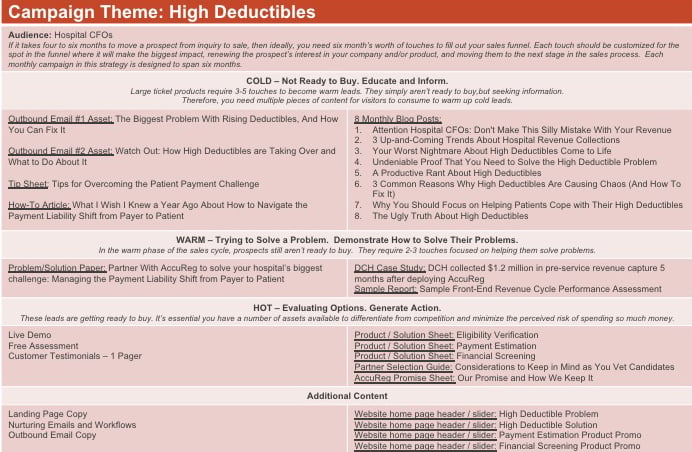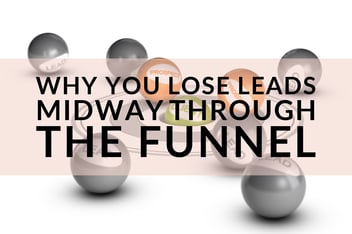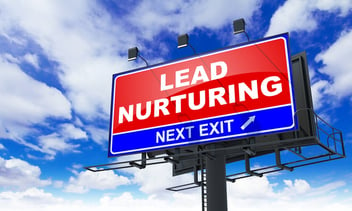4 Reasons To Use Lead Nurturing (And 3 Free Tools To Get You Started)
.png?width=550&name=4%20Reasons%20To%20Use%20Lead%20Nurturing%20(And%203%20Free%20Tools%20To%20Get%20You%20Started).png)
In B2B marketing, especially when marketing services such as technology solutions, project management, or consultation, decisions are not typically made the first time a prospect visits your website.
The decision to sign a contract with a vendor comes after much research and consideration in a buying cycle that can often take weeks or months — sometimes even longer. That means that pushing every contact or lead you get straight to sales is a waste of time (both for your sales team and for the contact, who may have just been starting the research process — after all, 8 in 10 business buyers do research before contacting a vendor).
Instead, you want to develop a relationship and maintain a connection from the beginning of the buyers’ journey to the end.
That is done through lead nurturing. Here’s why inbound marketing is perfectly suited to warming up leads before sending them on to sales by using automated lead nurturing.
What is lead nurturing?
In a nutshell, lead nurturing as a part of inbound marketing is a series of automated email offers sent to prospects who have converted to leads on your website by accessing an offer. Let’s use a real-life example from JONES client Primaris (who happened to use inbound marketing to launch into the national commercial market and generated more than a thousand online leads in their first year).
Each lead started when a prospective customer accessed a downloadable offer on the Primaris website. In this case, a whitepaper. They access the whitepaper through a landing page by filling out a form that includes contact information.
That action then triggers the automated system, not to have a sales person call them immediately, but to send a welcome email, including links to the company’s blog and social media accounts, and an invitation to share the whitepaper with others. That email is followed up by others offering additional information that the lead might find useful.
With each interaction, the lead is offered content that moves them through the sales funnel toward a purchase, until they are showing the signs of being a qualified lead who is ready to make a decision.
Only then is the lead turned over to the sales department, complete with the lead intelligence that will prepare the sales team to find the right solution for the lead and close a deal.
Why use lead nurturing?
As we mentioned before, most leads aren’t ready to go straight to sales. Instead, they are seeking information to help them make a decision. With lead nurturing, you can be the one to provide the information they need. It’s good for them, and it’s good for you.
1. Automated lead nurturing is timely.
Rather than dropping leads into a system of random mass emails, which may not be sent right away, an automated lead nurturing system instantly responds with a follow-up email. Why is that so important? Because 25 to 50 percent of sales go to the vendor that responds first.
A quick response also increases the click-through rate on the subsequent email. Studies consistently show that CTRs decline with the age of the lead, so respond right away.
2. Did we mention it's automated?
That means once you set up a lead nurturing workflow, the system does the rest. Emails are set to be sent at specific intervals depending on the action taken by the lead, with offers that apply specifically to the initial interaction the lead had with your website.
The result is less work for you, and a potentially shorter sales cycle for your lead. In fact, Market2Lead found that nurtured leads have a 23 percent shorter sales cycle than those without lead nurturing.
We use HubSpot’s robust platform for our inbound marketing content management, lead nurturing automation and CRM. It provides a one-stop shop for our needs, under a single dashboard. Learn more about HubSpot and about choosing an agency to help you maximize the tools available through it in these blog posts:
3. Automated lead nurturing is targeted.
Going back to our Primaris example, if a lead initially converts on a landing page for a whitepaper about registry abstraction and using data in healthcare, it just makes sense to follow up with an offer related to that first one, which is why the second email in the series includes a link to download “Essential Resources For Staying Current On Registry Abstraction Requirements.”
To establish automated lead nurturing, you set up a lead nurturing workflow —similar to a flowchart structure — that provides a series of offers related to the topic that brought the lead to your site in the first place.
You would start with a campaign strategy and plan similar this one from another healthcare-related company, AccuReg, which outlines the content that appeals to buyers through all stages of the sales funnel.

Then you would use a template like this to plot out the landing page copy, calls-to-action and specific timing of each email in the nurturing workflow — all targeted specifically to your lead’s interests and current stage in the buyers’ journey.
4. Nurturing emails have higher CTRs than generic emails.
In an analysis of more than 1,200 businesses in its customer database, JONES partner and inbound marketing software provider HubSpot, found that click-through rates for lead nurturing emails averaged 8 percent, compared to 3 percent for generic email blasts.
Of course, you still need to follow some basic rules for email marketing. Check out the tips and stats in these posts and downloadable resources:
What do you need for lead nurturing?
In order to implement lead nurturing, you need to find the right tools. Choosing the right software will ensure that your campaigns are run smoothly with the least amount of effort. The software should manage the content, the contacts, the emails and the events that trigger the emails. As I said earlier, we love HubSpot because it can do all of this. We are a certified HubSpot partner agency, and are ready to help you implement HubSpot for all of your inbound marketing needs, if that is the right solution for you.
If you want to compare other options, as you evaluate marketing and lead nurturing software, be sure to consider these questions:
-
Is the tool easy to set up and manage?
-
Does the software help grow my contact list, or just reuse an existing list?
-
Does the software integrate easily with other marketing software, such as my website, blog, landing pages, social media and SEO tools?
-
Do I need to bring in outside help to provide a jumpstart as I implement inbound marketing and automated lead nurturing?
Want more step-by-step details on the benefits of lead nurturing programs? Our Introduction to Lead Nurturing walks you through the process of setting up a campaign, along with providing a few best practices to keep in mind. And I promised in the headline to provide three free tools to help you get your own lead nurturing plan off the ground, right? You’ll find them in our Lead Nurturing Toolkit: a template for creating landing page content, where inbound leads begin; a template for sketching out workflows and the emails in them; and a sample workflow to show how lead nurturing looks for a real company. Of course, I am here for questions as you get started — I love see inbound marketing and lead nurturing succeed for others!
-1.png?width=1652&height=294&name=Jones(RGB)-1.png)

.png)










